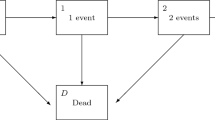Abstract
It is of practical importance to extend time-to-event models in order to be applicable in situations with recurrent events on the same individual or machine. The model proposed here extends in this direction a threshold regression model with random individual effects, in which event times are modeled as realizations of the first hitting times of an underlying Wiener process, leading to Inverse Gaussian distributions of times between events. In our approach, the parameters of the distribution of an event time may depend on features of the process (such as number of previous events and total elapsed time) as well as on measured, possibly time varying, covariates and the individuals’ random effects. A Bayesian approach is adopted for model estimation using an improved MCMC algorithm, which guarantees a proper choice of proposal distribution at any step of the hybrid Gibbs sampler when this is required. Model fitting is investigated using simulated data and the model is applied to a set of real data on drug users who made repeated contacts with treatment services.
Similar content being viewed by others
References
Aalen OO, Gjessing HK (2001) Understanding the shape of the hazard rate: a process point of view. Statist Sci 16:1–14
Abrahantes JC, Legrand C, Burzykowski T, Janssen P, Ducrocq V, Duchateau L (2007) Comparison of different estimation procedures for proportional hazards model with random effects. Comput Statist Data Anal 51:3913–3930
Barr DR, Sherrill ET (1999) Mean and variance of truncated normal distributions. Amer Statist 53:357–361
Chhikara RS, Folks JL (1989) The Inverse Gaussian Distribution: Theory, Methodology and Applications. Marcel Dekker, New York
Cox DR, Miller HD (1965) The theory of stochastic processes. Methuen, London
Griffiths W (2002) A Gibbs sampler for the parameters of a truncated multivariate normal distribution. Department of Economics - Working Papers Series 856, University of Melbourne
Horrace WC (2005) Some results on the multivariate truncated normal distribution. J Multivariate Anal 94:209–221
Lee M-LT, Garshick E, Whitmore GA, Laden F, Hart J (2004) Assessing lung cancer risk to rail workers using a first hitting time regression model. Environmetrics 15:501–512
Lee M-LT, Whitmore GA (2006) Threshold regression for survival analysis: modeling event times by a stochastic process reaching a boundary. Statist Sci 21:501–513
Pennell M L, Whitmore GA, Lee M-LT (2010) Bayesian random-effects threshold regression with application to survival data with nonproportional hazards. Biostatistics 11:111–126
Shubina M (2005) Bayesian analysis for markers and degradation. PhD thesis, Biostatistics Department. Harvard School of Public Health, Boston, MA
Whitmore GA, Ramsay T, Aaron SD (2012) Recurrent first hitting times in Wiener diffusion under several observation schemes. Lifetime Data Anal 18:157–176
Xiang L, Yau KKW, Tse SK, Lee AH (2007) Influence diagnostics for random effect survival models: Application to a recurrent infection study for kidney patients on portable dialysis. Comput Statist Data Anal 51:5977–5993
Yue H, Chan KS (1997) A dynamic frailty model for multivariate survival data. Biometrics 53:785–793
Author information
Authors and Affiliations
Corresponding author
Rights and permissions
About this article
Cite this article
Economou, P., Malefaki, S. & Caroni, C. Bayesian Threshold Regression Model with Random Effects for Recurrent Events. Methodol Comput Appl Probab 17, 871–898 (2015). https://doi.org/10.1007/s11009-015-9445-8
Received:
Revised:
Accepted:
Published:
Issue Date:
DOI: https://doi.org/10.1007/s11009-015-9445-8
Keywords
- Survival analysis
- Recurrent events
- Wiener process
- First hitting time regression
- Inverse Gaussian distribution




